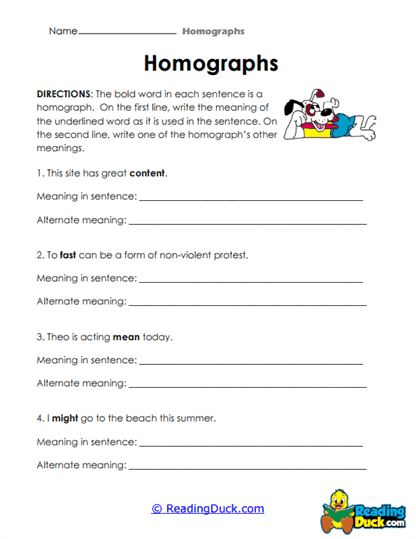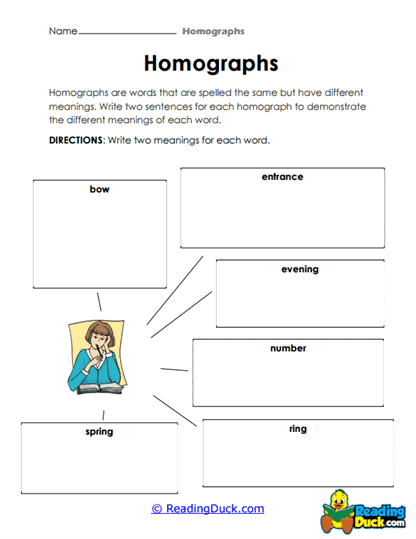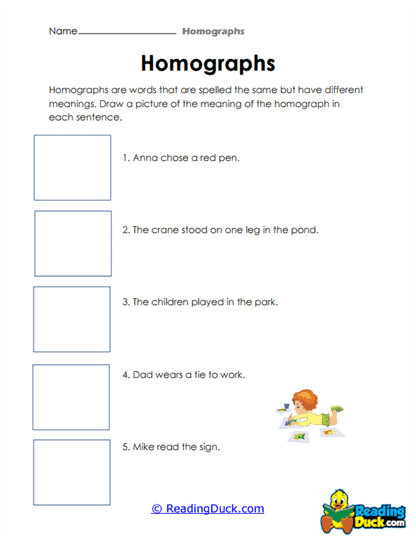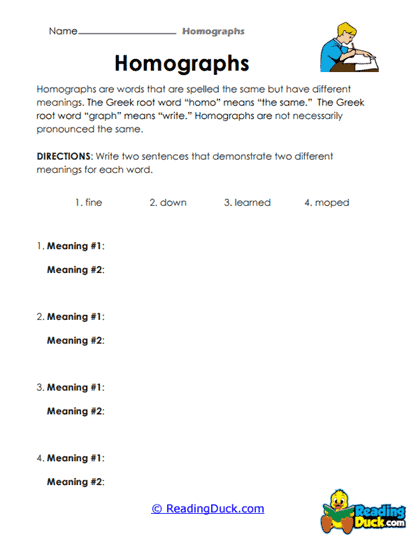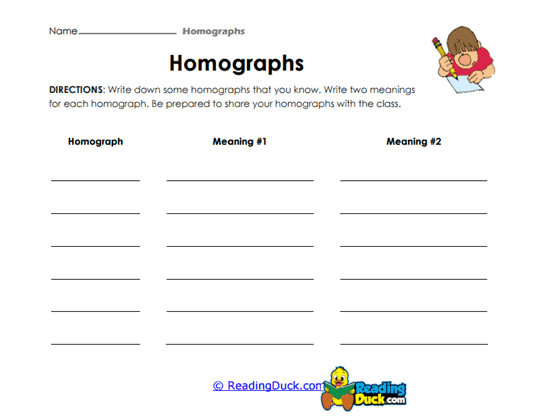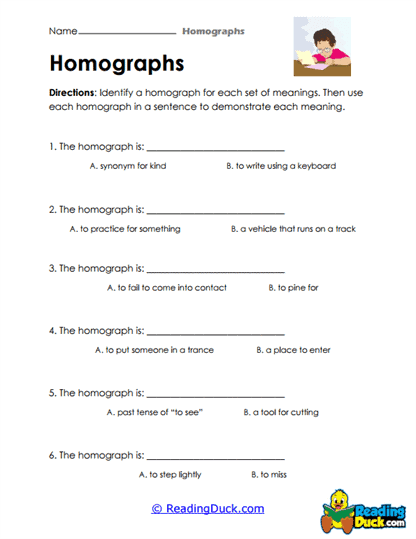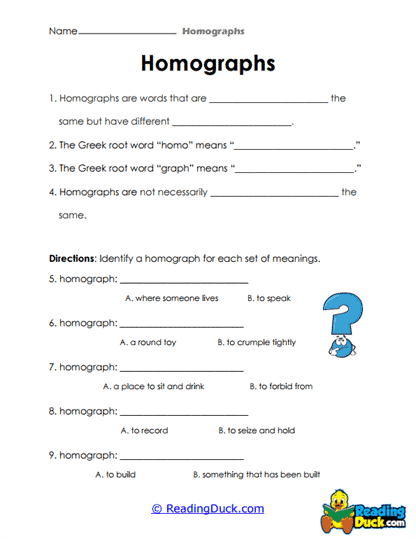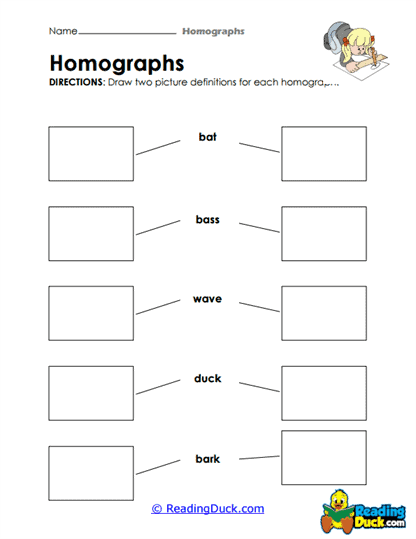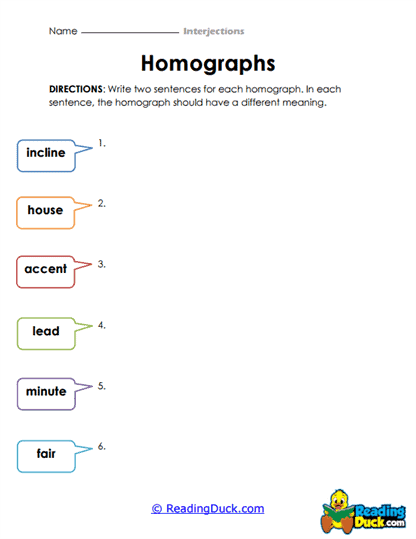Homographs Worksheets
About Our Homograph Worksheets
Our collection of Homographs Worksheets falls under the Language category within the Skills section. These worksheets are specifically designed to help students develop a solid understanding of homographs, which are words that have the same spelling but differ in meaning and sometimes pronunciation. By working through this collection, students will enhance their ability to distinguish between multiple meanings of words, improve their vocabulary, and refine their reading comprehension and writing skills. This set of worksheets provides a structured approach to learning homographs, helping students gain confidence in identifying and using them in context.
The worksheets are offered in PDF format, making them easy to view, download, and print for both classroom and home learning environments. Additionally, each worksheet includes a downloadable answer key, which allows students and educators to review and assess progress easily, ensuring that key concepts are understood and retained.
Defining Homographs
Homographs are words that share the same spelling but have different meanings, and they may also have different pronunciations. These variations in meaning and pronunciation can make homographs challenging to master, but they also provide students with an opportunity to strengthen their language skills by learning how to interpret words based on context.
What Are Homographs?
A homograph is a word that looks identical to another word in spelling but can have:
- Different meanings: The same word can refer to completely different concepts depending on how it is used.
- Different pronunciations (in some cases): Some homographs sound the same regardless of meaning, while others change their pronunciation when the meaning shifts.
Homographs are crucial to understanding the nuances of the English language because they demonstrate how context affects the interpretation of words. Some common examples of homographs include:
Lead:
-
- Meaning 1: To guide or direct (pronounced leed).
- Meaning 2: A type of metal (pronounced led).
Bow:
-
- Meaning 1: To bend forward in respect (pronounced bow, rhyming with "cow").
- Meaning 2: A tool for shooting arrows (pronounced boh, rhyming with "snow").
Tear:
-
- Meaning 1: A drop of liquid from the eye (pronounced teer).
- Meaning 2: To rip something apart (pronounced tair).
Why Homographs Matter
Homographs play a crucial role in language because they show how a single word can take on multiple meanings depending on its use. Understanding homographs helps students become more attentive readers and more effective writers, as they learn to rely on context to determine the intended meaning of a word. Moreover, mastering homographs enhances students’ ability to interpret language flexibly and broadens their overall vocabulary.
Common Challenges and Strategies for Mastering Homographs
While homographs enrich language, they can also present unique challenges for students, particularly when they are first introduced to the concept. These challenges often arise from the dual nature of homographs—where one spelling can yield two or more meanings, sometimes with varied pronunciations. Here, we will discuss some of the common hurdles students encounter and offer strategies to help them overcome these difficulties.
Challenges Students Face
- Context Dependence: One of the most common challenges with homographs is that students must rely heavily on context to determine which meaning of the word is being used. For example, when encountering the word "row," a student needs to assess whether it refers to a series (as in "a row of chairs") or an argument (as in "a heated row"). Without understanding the surrounding text, students might misinterpret the intended meaning.
- Pronunciation Differences: In some cases, homographs are pronounced differently depending on their meaning. This can be confusing for students, especially when they first encounter words like "lead" or "tear." They may struggle to recognize that the same spelling can produce different sounds.
- Multiple Meanings: A single homograph may have several meanings, making it challenging for students to remember all the possible interpretations of a word. For instance, the word "bat" can refer to both a flying mammal and a piece of sports equipment. Learning how to juggle multiple definitions can be overwhelming without the right strategies in place.
Effective Strategies for Learning Homographs
To help students overcome these challenges, educators can implement a variety of strategies that encourage understanding and retention. Some of the most effective strategies include:
- Contextual Clues: Encourage students to always look at the words and sentences surrounding a homograph to determine its meaning. For example, in the sentence, "She tied her bow," the context (tying) suggests that "bow" refers to a decorative knot rather than a weapon. Teaching students to ask questions such as “What is happening in the sentence?” or “What clues does the surrounding text provide?” helps them make sense of homographs more quickly.
- Word Sorting Exercises: Have students sort homographs into categories based on their different meanings. For instance, students could create one column for the word “tear” that relates to crying and another column for the meaning associated with ripping. This approach allows students to actively engage with the different meanings of homographs, reinforcing their understanding through repetition and categorization.
- Practice with Pronunciation: For homographs with different pronunciations, practice speaking the words aloud in their various forms. For example, students can take turns saying the word “lead” as it relates to guiding and then pronounce it as the metal. This type of exercise helps solidify the connection between pronunciation and meaning.
- Use of Visual Aids: Incorporating visuals that represent the different meanings of homographs can also be an effective strategy. For instance, showing a picture of a “bat” as a flying mammal next to a picture of a baseball bat allows students to associate each meaning with a visual cue, making the distinction clearer.
How Homographs Enhance Literacy Skills
Understanding homographs is an essential part of developing literacy skills, as it improves students’ abilities to navigate the complexities of language. The ability to differentiate between multiple meanings of the same word is particularly important in reading comprehension, writing, and oral communication.
Improving Reading Comprehension
By mastering homographs, students learn to interpret text more effectively. Homographs frequently appear in various forms of writing, and the ability to recognize the correct meaning based on context enables students to better grasp the overall message of a passage. For example, when reading a sentence like, "The dove flew gracefully," understanding that "dove" refers to the bird and not the past tense of "dive" is key to comprehending the sentence correctly.
Enhancing Writing Precision
For writing, homographs help students expand their vocabulary and use words more flexibly. A deep understanding of homographs allows students to choose the most appropriate word meaning for their sentences, enriching their writing with more precise and varied word choices. For example, knowing how to correctly use "row" to describe either a sequence of objects or a quarrel adds versatility to a student’s language toolkit.
Strengthening Speaking Skills
In conversation, understanding homographs ensures that students can clearly articulate different meanings and adjust their speech based on context. When students know the different pronunciations of homographs, they are more confident in their verbal communication and better equipped to avoid misunderstandings.
Supplementary Activities for Mastering Homographs
Educators can implement a range of activities to help students engage more deeply with homographs, ensuring they retain the material and find the learning process enjoyable. These activities can be conducted in classrooms or adapted for homeschool environments.
Interactive Learning Ideas
- Homograph Matching Game: In this game, students are provided with sets of cards. Each card has a homograph on one side and a sentence on the other that demonstrates one of its meanings. Students match the homographs with the correct sentence, reinforcing their understanding of the word’s different uses. This activity is suitable for elementary and middle school students.
- Role-Playing Scenarios: Have students act out scenarios where homographs are used in different contexts. For instance, one student could pretend to "lead" a group in a game, while another holds a piece of "lead." This allows students to physically engage with homographs and explore their various meanings in a fun, interactive way.
Homeschool-Friendly Activities
- Word Journals: Encourage students to keep a word journal where they record homographs they encounter during reading or daily activities. They can write down the word, note the different meanings, and include example sentences. This helps reinforce memory and provides a personalized reference for future use.
- Homograph Story Creation: Have students create short stories that include several homographs. They must use each homograph in a way that clearly demonstrates its different meanings. This helps them think creatively while reinforcing their understanding of how homographs work in context.
The Practical Importance of Learning Homographs
In conclusion, homographs are an important part of language that students must master to become fluent readers, writers, and speakers. These words show the richness and complexity of English, demonstrating how context shapes meaning and communication. By learning to navigate homographs, students become more adept at interpreting language, improving their overall literacy skills in both academic and real-world situations.
The practical applications of mastering homographs are vast. In everyday conversation, students will be able to understand and clarify meanings with greater accuracy, and in professional or academic writing, they will be equipped to use words more flexibly. Ultimately, understanding homographs enhances students' communication skills and prepares them for more advanced language challenges.
